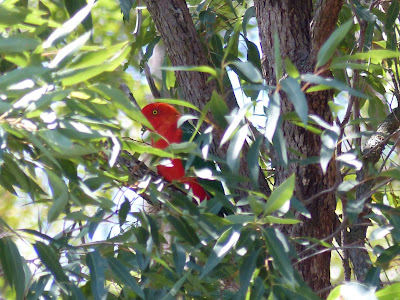This time we begin with the wonderful male king parrot, but in a more natural setting rather than being fed like the family back in October. Quite distinctive too. Notice the bare feather patch right in the centre of the chest. Still, such a majestic sight. I offer a few different poses for different perspectives and glimpses ... such a delight! First there is the initial glimpse of that regal king parrot red among the gum leaves; then three more "open" views, the final one a closer zoom offering a brighter view.
Next I had the peasure of capturing something of a favourite - an eastern yellow robin. I am more used to seeing in the darker confines of the forest at Victoria Park. Here in the more open scrub forest and on the fence post, a stronger sense of its tiny stature is more evident. The subtle grey tomes and yellow are a more clear in the open, though the ability to also "blend in" is far from lost as it sits against the bush background. I chose to also include the second shot because I liked the way it also looks at home and suitably safe among the built environment in teh foreground, contrasting with the bush block background.
Next, another "little" specimen it was good to see again - a jacky winter. Even tinier than he robin, it's pose atop the fence post clearly demonstrates the stature 😊. In (for me), a rare opportunity for a good close-up, the second shot of this study provides a sense of how well they camouflage, but also the ease with which they "fit" into their surroundings and appear larger than life when they allow to glimpse them "up close".
And, now what was the real and unexpected highlight of this visit for me. The humble white-headed pigeon. I have accumulated a few other photos of these now, and I most often sight them (almost exclusively to this point) on electricity wires after a rain event. They are plentiful. The light at such times has hitherto provided my sense of their "plainness" - white head and chest and grey wings and tail with reddish eyes and dull red feet. Just a plain variation on a feral pigeon! So, the conditions I guess had tainted my sense of a dull pallour and a plain appearance ... SO GOOD to have that refuted with this sighting in a far more natural bush setting with the gum trees offering a wonderful mottled sunlight that is a far cry from the post-rain electricity wire perches I am used to. Pleased to see them in a built environment, but like so much of this world the natural environment offers so much more 😁 - we need to respect that far more!
I really hope you enjoy the following selections that servie to illustrate the myriad variations in both white and grey that have been disguised and invisible to me previously! Even the feathers turn out not to be so smooth! The irridesence, noted in other pigeons and doves is clear and my previous lack of recognition of this is everythign to do with my powers of observation and nothing else. Time and patience ... looking ... and finally seeing! ENJOY, both the single bird and the pair!
And to round out this post, a couple of shots from our own backyard in an unusual tree we have. The jaboticaba (my spelling) orignates in Brazil and the fruit blossoms along the ranches and look like grapes or very dark cherries. The foliage is a fine small green leaf that offers wonderful coverage for birds. If you want to know a bit more about the tree & fruit, here is what Wikipedia offers. The lorikeets especially devour the sweet fruit once it is "on" (and take care of feeding at day, the fruit bats take over a get drunk at night!) ... here are a couple of photos of rainbow lorikeets in action showing both the nectar and translucent pearly flesh that is in the skin - they are actually very delicious when chilled - break the skin, pit the seed and suck the flesh out).















No comments:
Post a Comment